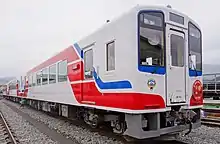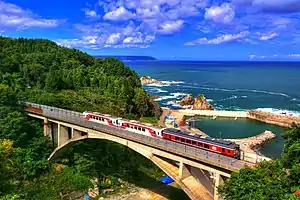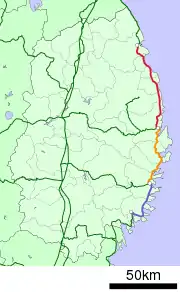Sanriku Railway
The Sanriku Railway (三陸鉄道, Sanriku Tetsudō) is a railway company in Iwate Prefecture in northern Japan. The company and its lines are also known as Santetsu (三鉄). The company was founded in 1981, as the first "third sector" (half public, half private) railway line in the country, excluding special cases such as freight railways in seaports. Its lines are former Japanese National Railways (JNR) lines, that were going to be closed. Santetsu acquired these lines in 1984. The company also operates a travel agency and other businesses.

Rias Line
| Rias Line | |
|---|---|
 A train crossing the Ōsawa Viaduct, September 2015 | |
| Overview | |
| Native name | リアス線 |
| Status | In operation |
| Owner | Sanriku Railway |
| Locale | Iwate Prefecture |
| Termini | Sakari Kuji |
| Stations | 40 |
| Service | |
| Operator(s) | Sanriku Railway |
| Rolling stock | Sanriku Railway 36 series DMU |
| Technical | |
| Line length | 163.0 km (101.3 mi) |
| Number of tracks | Single track |
| Character | Rural |
| Track gauge | 1,067 mm (3 ft 6 in) |
| Electrification | None |
| Operating speed | 90 km/h (56 mph) |

Red:Kita-Riasu Line
Blue:Minami-Riasu Line
Station list
History
Kita-Rias Line
The Japanese National Railways (JNR) opened the Miyako to Taro section in 1972 and the Kuji to Fudai section in 1975. It constructed the Taro to Fudai section, and transferred the entire line to Sanriku on the day it opened in 1984. The line features 42 tunnels, including the Masaki (6,532 m) and Omoto (5,174 m) tunnels, both opened in 1984.
Minami-Rias Line
JNR opened the Sakari to Ryori section in 1970, extending the line to Yoshihama in 1973. It constructed the section to Kamaishi and transferred the entire line to Sanriku on the day it opened in 1984. The line features 20 tunnels.
2011 earthquake and tsunami damage
Both lines were heavily damaged by the 2011 Tōhoku earthquake and tsunami.[1] The two lines suffered damage at 300 locations, including damage to station buildings and bridges. The tsunami washed away 5.8 km of railway tracks on the lines. Full restoration of service on the lines was completed in April 2014.[2]
Diesel railcars damaged by the earthquake and tsunami were replaced by three new diesel railcars funded by Kuwait. The new cars were introduced in January 2014.[3]
The two sections of the Sanriku Railway were for a long time separated by a destroyed segment of the Yamada Line.
On 23 March 2019, the Yamada Line section from Miyako to Kamaishi was reopened and transferred to Sanriku Railway. This joined up with the Kita-Rias Line on one side and the Minami-Rias Line on the other, which together constitutes the entire Rias Line restored. The result is a resumption of continuous rail service between Kuji and Sakari Station where it links with the Ōfunato Line.[4][5]
See also
References
This article incorporates material from the corresponding article in the Japanese Wikipedia.
- "Tsunami-hit Sanriku line fully operational". The Japan Times. 5 April 2014. Retrieved 16 June 2014.
- 三陸鉄道、新車両3両投入へ [Sanriku Railway to introduce 3 new cars]. Tetsudo.com (in Japanese). Japan: Asahi Interactive. 22 June 2019. Retrieved 22 June 2012.
- 三陸鉄道はいま、ひとつにつながるリアス線 (in Japanese). Retrieved 14 June 2018.
- 東日本大震災 復興鉄路つながった 8年ぶり宮古-釜石、三陸鉄道に [Great East Japan Earthquake Railway have been rebuilt and connected after 8 years reconstruction between Miyako-Kamaishi, Sanriku Railway]. mainichi.jp (in Japanese). Japan: The Mainichi Newspapers Co., Ltd. 23 March 2019. Retrieved 24 March 2019.
External links
| Wikimedia Commons has media related to Sanriku Railway. |
- Official website in English
- Official website (in Japanese)